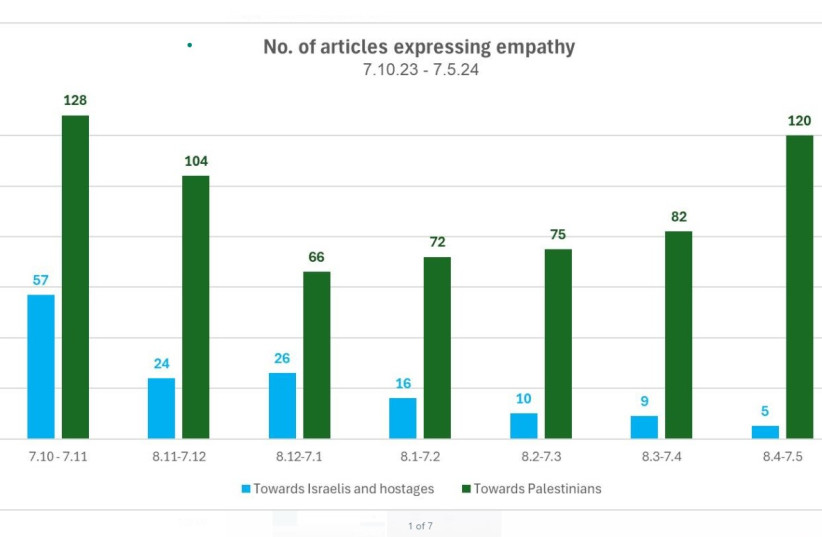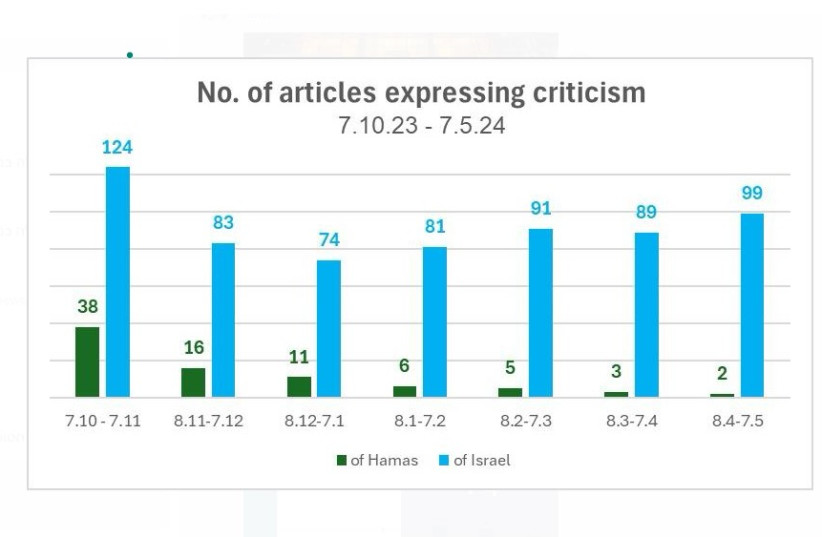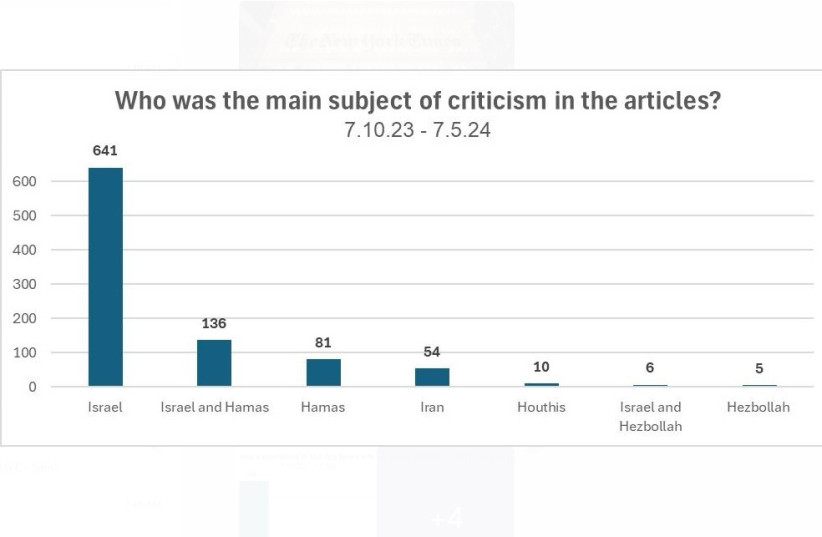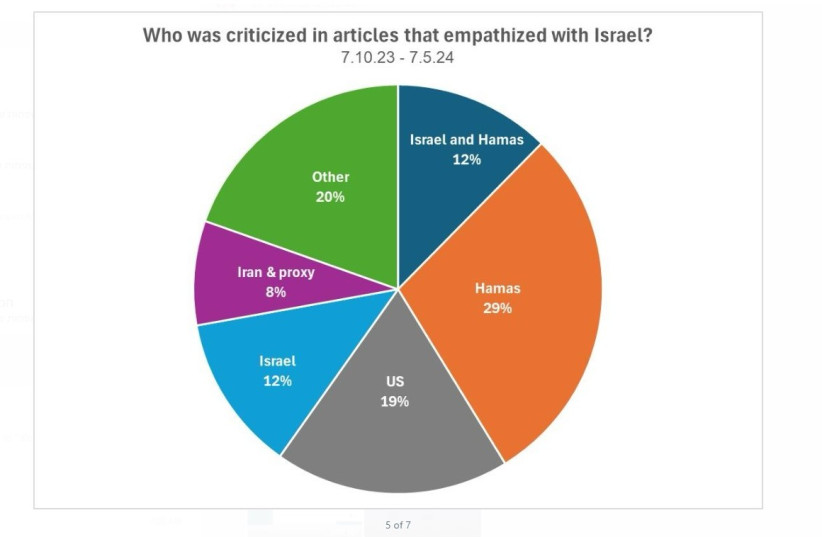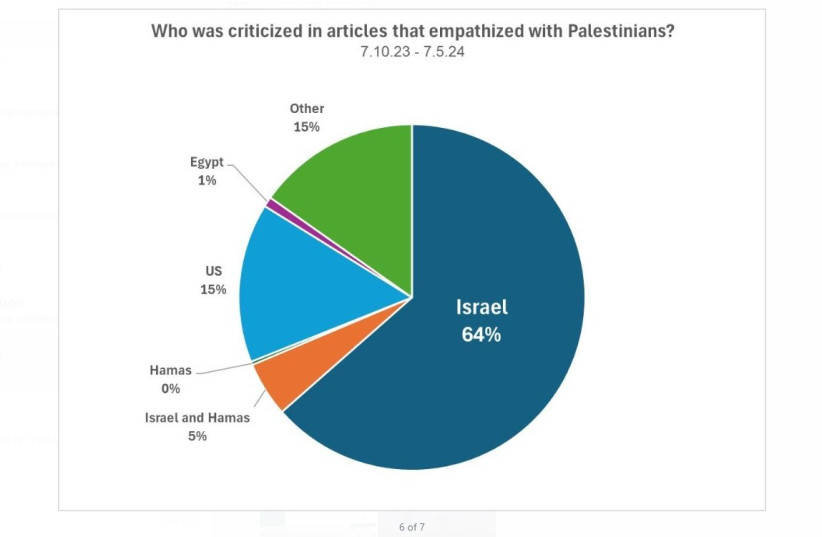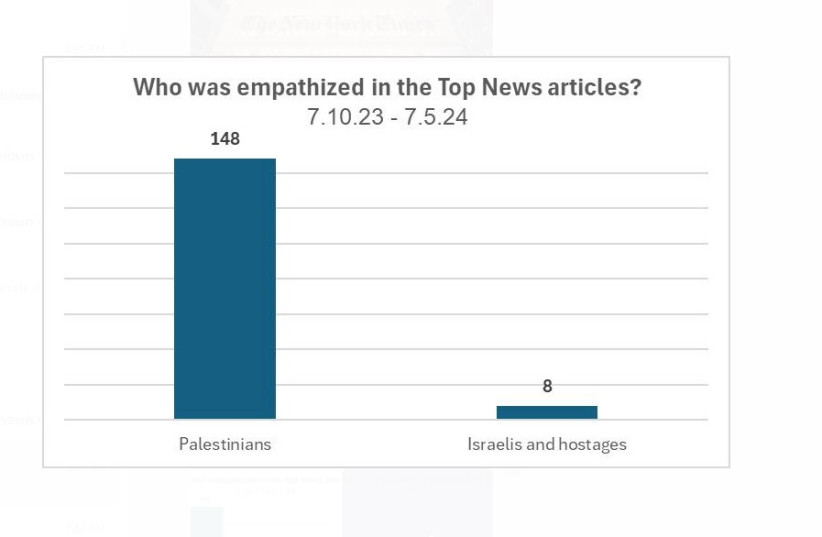Alongside winning the Pulitzer for seven articles that covered the war, the New York Times was heavily criticized for its biased and problematic reporting. The harsh allegations did not only come from Jews and Israelis but surprisingly also from pro-Palestinians, who actually claimed that the Times was pro-Israeli.
So what is the truth behind the contradicting claims and accusations? The answer can only come from monitoring and quantifying the mass of the coverage. And it was definitely massive.
During the first seven months of the war, from October 7 to May 7, the number of articles published in the Times on the subject reached 3,848.
Just for comparison - during all of 2022, the number of articles covering Israel in The Times reached only 361. Less than one-tenth in double the time period.
Analyzing the New York Times articles
Since the number of headlines was enormous and very complicated to rank according to size and salience, we decided to analyze only the articles that the Times itself defined as most important - those that were placed in a newsletter called Today's Headlines.
It is a daily email for subscribers that requests a summary of the main news from the past day, selected by the editors. Seeing that these are regarded as the day’s most important news by the editors, they are most probably the ones that were given the biggest size and salience, whether in the paper edition, the website, or the digital channels.
Only about one third of the total headlines published about the war made it into the newsletter, and they amounted to 1,398, from October 7 to May 7.
The number of articles peaked during the first month of the war, reaching 325 from October 7 to November 7th.
In November, it gradually decreased until reaching a low of 131 articles in February. But coverage began to rise again in March and spiked in April due to campus protests. The number of articles came to 255 from April 7th to May 7.
We coded the articles by two criteria: empathy and criticism. Each headline was examined according to whether it expressed empathy towards a particular person or group, and then according to whether it also expressed criticism towards an entity or group.
Sometimes, the critical tone was expressed towards parties that were less relevant to the research (such as the US, China, Russia, and Germany).
Sometimes, empathy was also expressed towards incidental parties that are less relevant to the research (such as American Jews, Lebanese, and others). Articles that did not express empathy or criticism received a coding of 0.
An obsession with Palestinian suffering
It isn’t very surprising to learn that the group that received the most empathy in the Times' articles about the war was the Palestinians. Out of a total of 1,398 articles, 647 expressed empathy only towards Palestinians (46.2% of the articles). 147 articles expressed empathy only towards Israelis (10.5% of the articles), 50 of which expressed empathy towards the hostages (2.9% of the articles).
If we summarize the entire 7-month period, Palestinians received 4.4 times more empathy than Israelis in general, and specifically the hostages.
However, when observing the data by month, the gap becomes much larger.
The graph shows that empathy towards Palestinians was almost double the level of empathy towards Israel and the hostages, even in the first month of the war, which was the peak month of empathy toward Israelis.
The October 7 massacre was the worst, most horrific deliberate violence against civilian Jews since the Holocaust and the pogroms in Eastern Europe.
Still, the number of articles expressing empathy for Israelis and hostages in October alone was 50, while the number of articles expressing empathy for Palestinians was 90. From then on, the gap only widened.
Empathy towards Israelis (including hostages) dropped by more than 50% in November and kept shrinking from January forward until it almost disappeared.
Empathy towards Palestinians, on the other hand, reached its peak in November (116), decreased slightly in December and January, and began to rise again in February.
In January, empathy towards Palestinians reached a relative low of 63 articles but was still 26% higher than the number of empathetic articles towards Israelis in October, which was the peak month for empathy towards Israelis (These numbers differ from those featured in the graph because they cite calendar months and not war months).
From January, empathy towards Israelis (including hostages) plummeted almost to nothing. Empathy for Israelis was expressed in 16 articles in January, 10 in February, 9 in March, and 7 in April.
Next to hundreds of articles expressing extreme empathy towards Palestinians (63 in January, 72 in February, 76 in March, 100 in April) – it’s easy to mistakenly assume that Israelis are not really suffering from the war. That is very far from the truth.
It should be noted that 69 of the articles published during the whole seven months expressed empathy to both Palestinians and hostages or Palestinians and Israelis. But that will be elaborated in a follow-up article next week, not in this one.
Who is criticized when someone is empathised?
While the obsessive empathy towards Palestinians can somehow be explained, one of the main problems is revealed when crossing empathy with criticism. Who is the party responsible for the suffering of the Palestinians, which is incessantly reported, or for the suffering of the hostages or the Israelis?
Out of 50 headlines about hostages, only 28 expressed criticism of Hamas. 11 criticized Israel for their suffering, 6 expressed joint criticism of Israel and Hamas, one criticized the American attitude towards the hostages, and the rest did not express any criticism.
In contrast, out of 647 articles expressing empathy towards Palestinians, only two were phrased in a critical tone towards Hamas.
33 expressed criticism towards both Israel and Hamas, and a whopping 479 expressed criticism exclusively towards Israel. Only two out of 647 articles expressing empathy towards Palestinians expressed a critical tone towards the Palestinian Authority (one of them, along with criticism of Israel).
The first week of the war, from October 7 to 13th, appears to be the only time in which there was some balance in the reporting: out of 69 articles about the war, 14 criticized Hamas, 12 criticized Israel, and 14 criticized both.
In other words - in the week immediately following the most devastating and barbaric massacre that ever took place in Israel, while bodies were still being identified, there was an equal amount of criticism towards Israel and Hamas. From there - it only deteriorated.
The clear subtext in these proportions is that Israel bears much more responsibility for everything. Specifically, it supposedly bears much more responsibility for the suffering of Palestinians than their elected government, whether in Gaza or the West Bank.
This is a highly problematic message, which contradicts the declared position of The Times' editorial board, which repeatedly advocates for an independent Palestinian state.
How can one demand more independence while ignoring the fact that the Palestinians used the disengagement, which was de facto Gaza's independence from Israel, in order to elect Hamas as a government, which is now not responsible for the current situation of its constituents?
This approach was very visible in the analysis of the opinion section as well.
72 op-eds harshly criticized Israel during the war, and they were written by a variety of Jews, Muslims, Israelis, Palestinians, and Christians. But out of all 23 op-eds that expressed criticism towards Hamas, not even one was written by a Palestinian or even by a Muslim. Most of them were written by Jews or Israelis.
If that’s not enough - during the entire war, only one op-ed written by a Palestinian criticized the Palestinian Authority.
Why is there such a narrow stage in the Times, if any, for Palestinians to criticize their government? Is the Palestinian leadership completely immune to internal criticism, even if it’s a designated terror organization?
To sum it up, empathy towards Israelis (including hostages) was crossed with criticism directed at Hamas in less than 4% of the articles. However, empathy towards Palestinians was crossed with criticism towards Israel in more than 34% of the articles. This is one of the most important bottom lines when discussing proportions. They don’t really seem to exist in the Times’ reporting.
A matter of priorities
The glaring disproportional criticism is particularly jarring when observing only the Top News category of Today’s Headlines - meaning the three most important headlines that are featured at the top of the newsletter every day.
Reports about the war appeared daily in at least one of the three headlines in the Top News of the newsletter and sometimes even in all three.
Out of 276 Top News headlines during the seven months of the war, 151 expressed empathy exclusively towards Palestinians (55% of the headlines).
Only 16 headlines expressed empathy towards Israelis (5.8%), and half of them specifically towards the hostages. In addition, 130 out of 150 headlines that expressed empathy towards Palestinians criticized Israel, meaning more than 86%.
Out of the 16 headlines that expressed empathy towards Israelis and hostages – which amounts to less than 6% of the headlines about the war - only six headlines criticized Hamas (which amounts to 37.5% of the Israeli empathizing headlines).
The inevitable conclusion is that the Times’ editorial line clearly diverted attention away from Hamas, which started the war and refused prisoner exchange deals, and aimed it toward Israel.
One must also remember why Hamas executed the massacre, burning, beheadings, and rape: to thwart the emerging alliance between Israel and Saudi Arabia, which would establish the moderate, peace-seeking axis in the Middle East against Iran's axis of terror.
This is an explicit American interest, which the Times de facto worked against. Just to be clear - the Israeli government and its extremists deserve a great deal of criticism for their conduct before October 7 and also throughout the war. But where did the criticism of Hamas disappear to? One does not necessarily have to negate the other.
In addition, the claim that the Times has a pro-Israel bias is not just a bad joke but a false and manipulative claim.
It seems that those making it are radicals attempting to increase their power in institutions of knowledge, whether leading universities or leading media outlets.
In their view, there is only one correct narrative, in which Israel is wicked and the Palestinians are holy, and anyone who deviates slightly from the narrative is immediately attacked for being "pro-Israel." It is reasonable to assume that was the reason behind progressive extremists attacking the Times - in their view, Israel must be completely denunciated, and disproportionate coverage is just not enough.
The Times still defines itself as liberal, but its emphases and scope of coverage during the war point to a clearly progressive editorial line.
This matches the claims raised in December 2023 by two of its former senior staff members, James Bennett and Judith Miller, who said that the Times has long ceased to be a liberal newspaper and has become illiberal, tribal, and intolerant.
The discrepancy between the Pulitzer Prize that the Times won for seven articles that covered the war, and the data which shows misleading and disproportionate coverage was explained very well by Miller in her article: "While the Times still does some extraordinary reporting, it is doubtful that its reputation for slanted, ideologically driven journalism can be reversed."
Data collection: Ido Shapira and Kelly Galay Article analysis: Efrat Tzori
The writer is an Israeli author, journalist, and Prof. Eytan Gilboa’s co-researcher in a Bar Ilan study about the coverage of Israel in the New York Times

